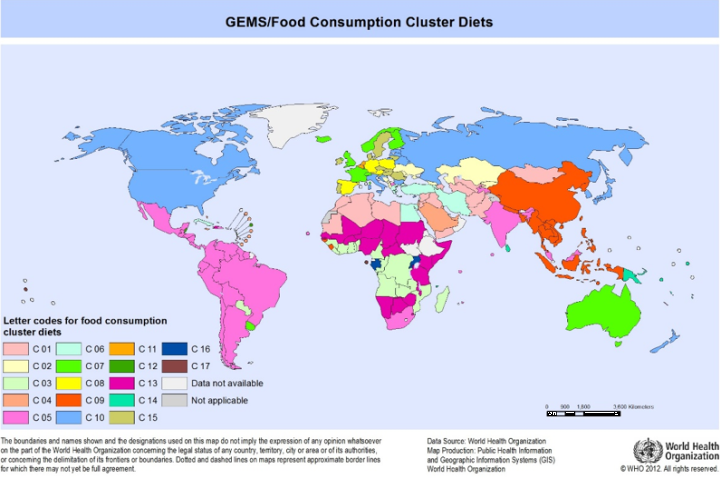Regional cluster diets [edit]
Principle
The assessment of pesticide exposure through the diet combines pesticide residue levels on agricultural commodities with consumption data of those commodities.
Generally, food balance sheets are used as an approximation of per capita food consumption. A food balance sheet presents a comprehensive picture of the pattern of a country's food supply during a specified reference period. The food balance sheet shows the availability for human consumption for each food item.
National food balance sheets are preferred as a basis for dietary risk assessment of pesticides, as they are specific to the food consumption in a given country. However, up-to-date and reliable food balance sheets may not be available in all countries.
In absence of national food balance sheets, the regional cluster diets established by GEMS/food are used for dietary risk assessment (WHO Global Environment Monitoring System – Food Contamination Monitoring and Assessment Programme). At present, GEMS/food has defined 17 different regional cluster diets. The cluster diets represent the average per capita consumption of 179 countries during 6 years (2002 – 2007). Countries within the same cluster are considered to have similar diets.
The resulting cluster diets are shown on the map below. More details can be found on the GEMS/food web site.

When bridging a residue assessment between the local situation and a reference country, one needs to assess whether the diet used for risk assessment in the reference country is applicable to the local situation. In principle, if the reference country is from the same cluster, one can expect the diet to be similar to the local situation.
However, a reference country from a different cluster may still have sufficiently similar diets to allow bridging of the residue assessment. The registration authority will need to compare both national diets to decide whether they are sufficiently similar. More detailed food consumption data for each cluster can be found on the GEMS/food web site (click on the spreadsheet “Data – consumption 2012”).
On the other hand, if a regulatory authority considers that there are specific national food items under- or overrepresented in the regional cluster diet, it can amend food consumption quantities in the spreadsheet templates used for dietary risk assessment. {link to A07-01-02-#1} However, it is recommended to make modifications in the regional cluster diets only if very reliable national data are available. In such a case, it may be better to establish a national food balance sheet instead.
